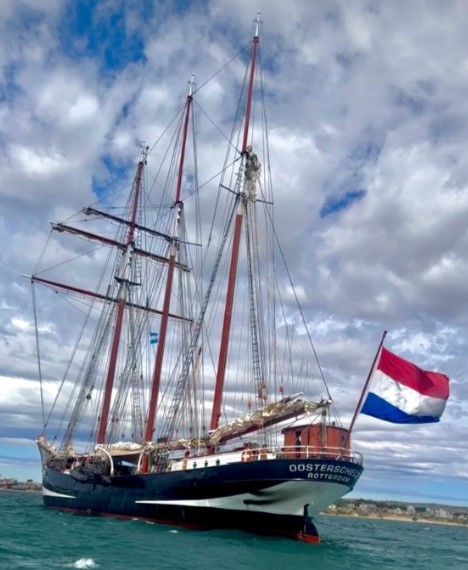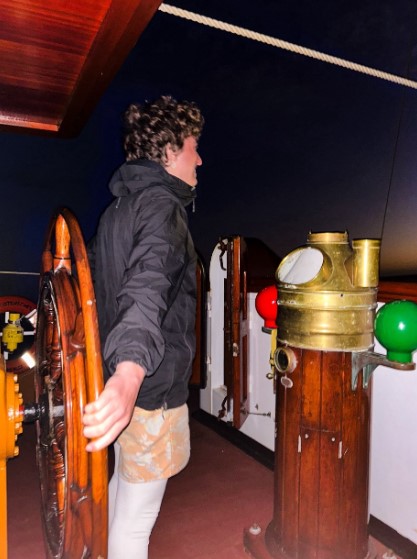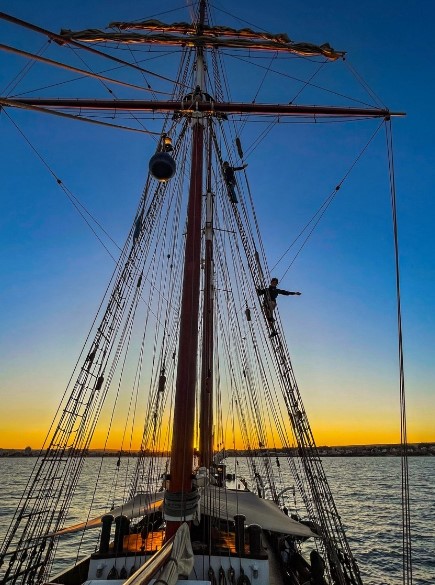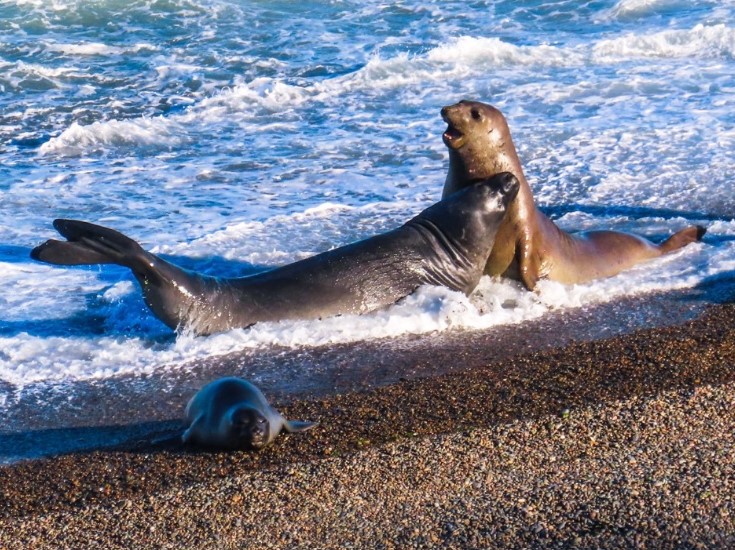By Gabriel
Punta del Este, Uruguay. Mission: Save the Sharks. Project: Darwin200. Time: 1 week.
I had the fortune of being selected as a Darwin Leader for an expedition that is training 200 young conservationists from around the world.
The Darwin200 Expedition: Recreating the voyage that Charles Darwin made aboard the Beagle almost 200 years ago. This is a 2-year long global voyage on a 150-foot tri-masted topsail schooner which stops in the ports Charles Darwin visited. At each port student leaders study the conservation of many of the same species Darwin studied to share the changes in conservation status and bring global attention to conservation.
I was appointed to direct a project to create a 3-part docuseries on the conservation of sharks in Uruguay. This has been one of the most exciting weeks of my gap year thus far. When I arrived to the 50-meter Oosterschelde in Punta del Este, base camp for the project, I met the amazing Sharon. She was the professional filmmaker who worked side by side with me to make this production possible. I also was partnered with the head of a local non-profit called Mar Azul Uruguayo who helped me to handle the logistics on the ground including setting up the interviews in the field.

When I talked about the plan for the week, my first request was to get underwater footage scuba diving with sharks locally. The nonprofit disappointedly told me this was impossible in Uruguay due to scuba diving being virtually outlawed and nonexistent. I learned that the only sharks that we could film were dead sharks. This was a very unsettling reality check. “At least this means we are tackling this expedition where it is greatly needed,” I thought to myself. My love of the ocean and everything beneath it was truer to me than ever.
After sleeping on the boat which resembled a pirate ship, we set off to seek our treasure. We reached the first X on the map: Punta Del Diablo meaning “point of the devil”. Here a local shark fisherman had saved some gold for us. A dead shark. After learning about the struggles of fishing, including the dangers and unpredictability of the job, and the decreases he experienced in population, size, and energy per catch, it was time to test my stomach.
We wanted to record the preparation of the sharks before being sold. Watching an apex animal older than the dinosaurs be sliced to pieces and be standing in a pool of blood had every piece of my body in physical and emotional pain. The discomfort I felt however was nothing compared to what 40 thousand tons of sharks exported through Uruguay in the last 10 years have experienced. We were super fortunate to be able to witness and document this experience. We spent hours with the fisherman learning every facet of the industry to be able to communicate what needs to change for the future to be brighter for sharks, local fishermen, and the ecosystem they look after.

I quickly learned how multifaceted the issue really was. The fisherman did not find any joy killing sharks. This was the only thing he knew how to do to support his family. He shared his dream for a change. To have the support to shift away from the industry. The preferred alternative: taking tourists out to catch and release sharks. His roadblocks: money and permits. When we were leaving his store, I noticed a huge bucket full of algae. He told me that recently he started collecting it as it washed onshore. He had been making additional money by selling it to a friend who had two markets for it- as a replacement fertilizer and as a menu option to restaurants. This brightened up my day since I love algae. We enjoyed raw algae together at the end of the interview. We were not so different after all.

My next realization was how much shark meat is consumed- many times without people’s knowledge– both locally and globally. During this interview, a lady entered the store asking for fish. “We only have shark,” responded one of the workers. She responded, “I don’t want shark, I want cazón.” They sold her cazón and she walked out. Only later did I realize that cazón is a shark that is critically endangered, yet people do not know it is shark because the population is under enough pressure that the only ones caught are babies, so people think they are too small to be ‘real sharks.’
Uruguay is a breeding zone for sharks, and since the fishing pressure is so great, the majority do not reach reproductive maturity and are killed as juveniles.
To gain insight into the restaurant industry’s role in feeding people sharks, we interviewed a chef that used to have them on his menu but removed them because he could see the population decline with his own eyes. He observed that fishermen would use more and more nets and come back with fewer and fewer sharks ever smaller in size.
We learned that he has been able to switch to many fish that are lower on the food chain, decreasing the ecological footprint of his plates. He also, much to my happiness, used algae in many of his dishes, replacing other greens that were more expensive and had to be imported. The most popular seaweed dish: buñuelos de alga, is a specialty of the region. To support his eco conscious moves, we returned later to have dinner. I got the buñuelos, aka seaweed fritters. They did not disappoint.

I interviewed many other stakeholders all around Uruguay during the expedition. The most shocking was an interview we had scheduled with scientists who worked for the government. When we arrived and requested them to share on camera what research and conservation they are working on, they shared they were too scared to get on camera. I assured them they would not need to state any opinions, and we could not show their faces, and even alter their voices to be unrecognizable. Despite their enthusiasm for our project, and strong desire to be able to talk, they feared saying anything that would get them fired. I was shocked. How fishy.
Luckily, we were able to hear from Mar Azul Uruguayo and a local university scientist about the current regulations in place as well as the research being done. We learned about the heavy metal risks of eating apex predators. It was very disconcerting, especially when many Uruguayans do not know they are eating sharks, and the ones that do are not aware of the health risks posed.
I also learned that this issue is much larger than Uruguay. Even in England, researchers took DNA samples of food from fish and chip restaurants and found 90% of the samples contained sharks.
With my mind spinning and only a day to draft our first video of the docuseries, we headed back to the pirate ship. Determined to communicate all this new understanding to a global audience, we worked tirelessly as the ship swayed back and forth, and the sun went further down on the horizon. Motivated to create value in our work, Sharon and I did not stop until the sun had made it all the way around the globe and came back up the other side. Part 1 of 3 was complete.
After presenting the first of the 3-part series to many local stakeholders that night, it was officially the end of Darwin week.

When I walked the plank between the boat and the dock, my biggest hope was that this would not be my last time on the boat. With a little bit of luck and serendipity, a spot opened on the boat for the next segment of its voyage, and I was offered to join the sailing leg to Puerto Madryn, a town in Argentinian Patagonia. I was ecstatic! My pirate dreams could finally come true.
It was surreal sailing on such an historic ship. We sailed out of the port, and it did not take long before hardcore sailing began. With no winches for the sails, they relied on human power to be raised and adjusted. No autopilot required someone at the helm navigating with the compass. We each were assigned to a group and had 10 hours on shift each day. The most difficult for me: night shifts. We were either on from 8-12am, 12am-4am, or 4am-8am. There was a silver lining, however: The Milky Way. Hundreds of miles offshore there is no light pollution. On a clear night, we had the best stargazing. This did not even compare to the show the ocean gave us at night. After being woken up for my midnight shift, I was told the whole ocean was glowing. To my surprise, this was not an exaggeration. Bioluminescent algae made every wave bright green and blue. Color and light were all around and more beautiful than I had ever seen.

All the sailing shifts and my sleep deprivation from Darwin Leader week left me exhausted. Most of the time that I was not sailing I would find somewhere and lay there. Even on the deck of the boat. I gained the label of being a reptile as I was always looking for a sun-kissed area to lay down for warmth.
I was lying on a couch in the saloon one day, right up until I heard a faint yell from up top. “Dolphin! Dolphin!” I thought to myself, ‘Eh, I’ve seen many dolphins, I’m too tired to get up.’ Then I reevaluated my rationale and jumped to my feet, running across the boat and up the stairs. I ran to the side of the boat to see a huge black fin in the water. That was no dolphin. It was an Orca. Right before my eyes it jumped several feet out of the water only an arm’s length from the port side of the boat. Now that was worth getting up for!
We saw many pods of common dolphins, different species of pelagic birds such as petrels, shearwaters, albatrosses and even the furthest south brown booby ever documented. (Thanks to Grant aka birdman who is leading a worldwide bird survey for bird facts.)
While awake, I sometimes was not able to tell whether I was overly exhausted, seasick, or both. It was after dinner one day that seasickness prevailed. I lost my dinner and after that most of my excitement to eat. I no longer joined the others down below deck at the dinner table as I felt more seasick there. Instead, I went down only to serve myself each meal. Then I carefully balanced a plate of food, soup and water in my hands as I went to the deck to eat. This ritual turned out to give me the experience of many magical sunsets. In my mind a blessing in disguise that I was unable to eat at the dinner table.

After a week of sailing, we had the last night ahead of us. The captain called a meeting. He informed us we would pass through a Gale force 6 or more storm in the middle of the night and would jibe during it.
I had already had bad experiences with the Beaufort scale. Earlier in my gap year in Norway in a Gale force 8 storm where my tent almost flew away with me in it, and my shoes flew off a thousand-foot cliff.
When I woke up at midnight for my shift, I was sliding back and forth in my bunk. I could hear waves washing over the deck of the boat. I could not stomach moving around with such rough waters bouncing the boat around. My dizziness would likely make me a safety hazard I conjectured. After being dismissed from duty, I dozed off, only to see and feel water cascading down the cabin through a tiny opening in the hatch. The next time I woke up my head was 2 feet lower than my feet, resting on the headboard. We had jibed.
After adjusting and dozing off, I woke up and it was eerily calm and bright out. I went upstairs, and to my amazement: land ho! Huge sandy cliffs right against the turquoise blue sea were on the horizon.
We sailed into Golfo Nuevo, the bay of Puerto Madryn. The calm seas gave the perfect opportunity to watch the last sunset from the crow’s nest (my favorite spot on the boat).

On shore, we had some very important wildlife to see including sea lions, elephant seals, guanacos, and penguins. We set off for Peninsula Valdez. A few hours into driving on dirt roads through the bush, we started passing groups of guanacos! Then we made it to a beach full of penguins, and then sea lions and elephant seals. The magic of Patagonia surrounded all of us.




A couple days later was the start of Darwin Leader week for Puerto Madryn. One day I worked with Oli and her project on puma conservation to capture the interviews and drone footage. I learned the largest threat to pumas, were farmers who owned sheep, as the farmers would shoot or trap them since they prey on their sheep. One of the solutions: sheep dogs as they protect the sheep from the pumas hunting them which in turn protect the pumas from being killed. We were super lucky to find a wild sheep dog protecting sheep.
The local conservation team wanted to take us further into the protected area to show the beauty of the ecosystem. As we were turning into the preserve, we stopped to get share some apples with the rest of the non-profit team in the car behind us. That is when they noticed the car was a little bit louder than it should have been. Then they saw a little bit of smoke coming from the hood of the car. When the car alarm went off spontaneously, they knew something was wrong. Everyone jumped in the bed of the truck we were in and sped off as quickly as possible. When looking back, we could only see a big plume of black smoke. Luckily, everyone was okay, and we had plenty of empanadas to share while watching the fire from a distance.
I sent the drone over to investigate the situation. The car had started a wildfire. We wanted to see if the firetruck had arrived. While in the air, I spotted a small red pickup truck coming from the distance. The firefighters! Then they took out their tools and started to fight the fire. First, with shovels. Yes, they shoveled sand and threw it at the truck. Amazingly, they were able to extinguish the wildfire after a lot of fighting with it. Thank goodness.
Everyone was a little shaken up. After everything had calmed down, we went into the reserve. I was able to capture drone footage of guanacos and rheas!

After a very full day it was time to gear up for my last adventure in Argentina. Scuba diving!
After meeting with a local scientist and underwater photographer studying invasive marine species, we arranged a dive so I could learn more about the work he does and see one of the most popular dive sites in the area. We went to El Folias, a 71-meter-long shipwreck. After putting on a lot of neoprene, we jumped into the 58 degree water and dove to the shipwreck. The wreck had transformed into a beautiful artificial reef, harboring many different species of fish and sea anemone. When Nicolás was taking a picture, a gray shadow came into view. A sea lion! It was very playful, and without him even noticing, it opened its mouth, gently grabbing his head.

After the dive, we sat in a friend’s van recounting the cool things we saw. It was an amazing dive! It would not have been Argentina without everyone sharing yerba maté. The time had come to say goodbye to Argentina and Darwin200. It was a truly magical experience that I will be forever grateful for. I cannot wait to continue my work in conservation while bridging the gap between science and public understanding with film. I am so happy to have been a part of the expedition and hope to reunite with the boat and crew again soon! Fair winds and following seas. Farewell maties!
